Uzbekistan & Turkmenistan Highlights
10 Days Private Tour of Ashgabat - Darvaza - Kunya Urgench - Khiva - Bukhara - Samarkand - Tashkent
Tour Type: Private guided tour, flexible and customizable
Transportation: Air-conditioned private car with experienced driver
Accommodation: 3 to 4 stars well-selected hotels & camp, open to your choice
Meals: 9 breakfasts and 1 dinner
Code: TCA102
Transportation: Air-conditioned private car with experienced driver
Accommodation: 3 to 4 stars well-selected hotels & camp, open to your choice
Meals: 9 breakfasts and 1 dinner
Code: TCA102
This trip can be customized to meet your individual needs!
Free InquiryGet our reply within 24 hours!
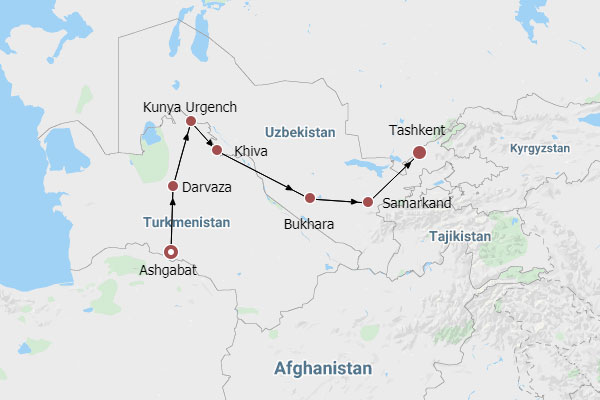
- Itinerary
- Reviews
Trip Highlights
- Traverse ancient walls to appreciate the well-preserved medieval town, Khiva, also known as an open-air museum.
- Witness the orange-red glow of the famous burning Darvaza Gas Crater by camping in the desert.
- Marvel at some of Samarkand’s finest Islamic architecture, like Shah-i-Zinda Necropolis, adorned with glazed tiles and inscribed clay.
- Discover the remnants of Kunya Urgench and learn about its glorious history destroyed by Genghis Khan.
- Ride the metro in Tashkent to see stations with various artistic designs, from cosmic themes to intricate mosaic decorations.
Expand All
Collapse All
Day 1 Arrive in Ashgabat of Turkmenistan, Visit Ertugrul Gazi Mosque & Parthian Fortress of Nisa
Upon arrival, our guide and the driver will warmly greet you at the airport, and then escort you in our air-conditioned private car to explore Turkmenistan’s capital, Ashgabat! Prepare to be captivated by its white charm, with most buildings clad in white marble and vehicles also in white.
Start our trip at Ertugrul Gazi Mosque, which is Turkmenistan’s most beautiful mosque with numerous paintings, gilding, and stained glass, and wander in Independence Park, where locals often relax on its expansive lawns and appreciate many ornamental plants. Then we’ll visit the National History Museum to delve into the country’s origins, from artifacts dating back to the Mesolithic period (50,000 BC) and the Bronze Age (3,300-1,200 BC) to findings from several ancient cities, including siliceous tools, seals, and a model of an ancient walled settlement.
Our next stop is the Turkmenbashi Ruhy Mosque (Gypjak Mosque) and Mausoleum, which were built to honor the former president, Niyazov. Beyond the eye-catching golden central dome, the mosque’s beauty reaches a new level with a series of waterfall-like fountains surrounding it. From a distance, those fountains seem to seamlessly support the mosque’s base, giving the impression of floating on water. Continue our visit to the UNESCO site, the Parthian Fortress of Nisa, the first capital of the Parthian Empire (247-224 BC), which comprises Old and New Nisa. In Old Nisa, you’ll discover the remnants of a well-planned royal palace, including a large hall, residential areas, and a wine cellar. These sites also witnessed cultural exchanges along the storied Silk Road, evidenced by excavated ivory rhyton drinking vessels and marble statues that blend Persian and Greek architectural styles. At the observation deck, you can also overlook New Nisa, where the remaining city walls and towers illustrate the formidable military power of the Parthians. Finally, you’ll be escorted to the hotel for rest.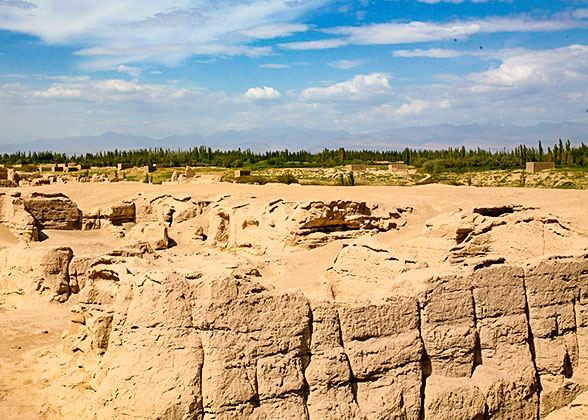
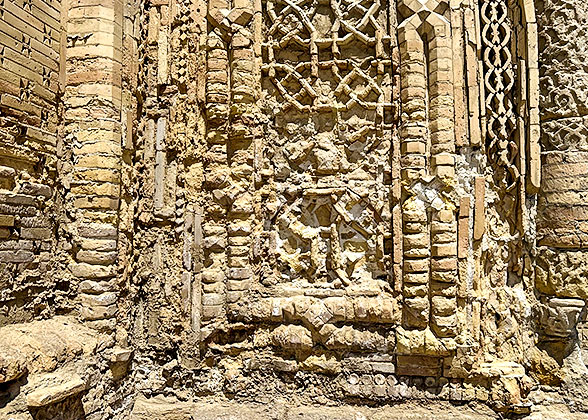 ► Tips:
► Tips:
1. Turkmenistan is known for its strict visa policy, which requires all travelers to obtain a tourist visa along with a Letter of Invitation from the travel agency through which they book their tour package. We will provide the letter for you, allowing you to get a visa on arrival at the airport upon landing.
2. Please bring enough US dollars to cover your expenses in Turkmenistan before departure, as credit cards are mostly unavailable. Due to the fluctuating exchange rate in Turkmenistan, which means exchanging local money would not be cost-effective, it is suggested that you exchange only a small amount with the help of the guide if you want to explore local bazaars or markets.
3. Considering the long drives between some sites and the bumpy terrain through the desert, we suggest that you pack some motion sickness pills and a mask for an easy trip.
Accommodation: Sport Hotel Ashgabat (4 stars) or similar
Start our trip at Ertugrul Gazi Mosque, which is Turkmenistan’s most beautiful mosque with numerous paintings, gilding, and stained glass, and wander in Independence Park, where locals often relax on its expansive lawns and appreciate many ornamental plants. Then we’ll visit the National History Museum to delve into the country’s origins, from artifacts dating back to the Mesolithic period (50,000 BC) and the Bronze Age (3,300-1,200 BC) to findings from several ancient cities, including siliceous tools, seals, and a model of an ancient walled settlement.
Our next stop is the Turkmenbashi Ruhy Mosque (Gypjak Mosque) and Mausoleum, which were built to honor the former president, Niyazov. Beyond the eye-catching golden central dome, the mosque’s beauty reaches a new level with a series of waterfall-like fountains surrounding it. From a distance, those fountains seem to seamlessly support the mosque’s base, giving the impression of floating on water. Continue our visit to the UNESCO site, the Parthian Fortress of Nisa, the first capital of the Parthian Empire (247-224 BC), which comprises Old and New Nisa. In Old Nisa, you’ll discover the remnants of a well-planned royal palace, including a large hall, residential areas, and a wine cellar. These sites also witnessed cultural exchanges along the storied Silk Road, evidenced by excavated ivory rhyton drinking vessels and marble statues that blend Persian and Greek architectural styles. At the observation deck, you can also overlook New Nisa, where the remaining city walls and towers illustrate the formidable military power of the Parthians. Finally, you’ll be escorted to the hotel for rest.

Parthian Fortress of Nisa

Ruins of Seyit Jemaletdin Mosque
1. Turkmenistan is known for its strict visa policy, which requires all travelers to obtain a tourist visa along with a Letter of Invitation from the travel agency through which they book their tour package. We will provide the letter for you, allowing you to get a visa on arrival at the airport upon landing.
2. Please bring enough US dollars to cover your expenses in Turkmenistan before departure, as credit cards are mostly unavailable. Due to the fluctuating exchange rate in Turkmenistan, which means exchanging local money would not be cost-effective, it is suggested that you exchange only a small amount with the help of the guide if you want to explore local bazaars or markets.
3. Considering the long drives between some sites and the bumpy terrain through the desert, we suggest that you pack some motion sickness pills and a mask for an easy trip.
Accommodation: Sport Hotel Ashgabat (4 stars) or similar
Day 2 Drive 4 Hours to Darvaza Gas Crater, Stop by Mosque Ruins & Akhal-Teke Horse Stable
In the morning, embark on an exciting 4-hour drive to Darvaza, stopping by the Seyit Jemaletdin Mosque ruins in the Anau area, where you’ll see scattered stone walls and mosaic pieces. Afterward, our guide will accompany you to the horse stable to admire the pretty Akhal-Teke horses, the pride of all Turkmen. This precious breed, with its slender head, high neck, and long limbs, undoubtedly is the supermodel of the horse world, boasting a remarkable speed as they can sprint one kilometer in just 67 seconds! When galloping for a long time, their capillaries will be visible through thin skin under the sun, and their fur color will become more vivid with sweat, creating an illusion of bleeding. If you prefer, take the chance to feel the thrill rush on horseback at your own expense.
In the evening, we’ll enjoy a BBQ dinner and spend the night at a nearby yurt camp, which provides pillows, sleeping bags, and mats. For the cool night air, you can bring a cardigan and thick socks to keep warm.
Meals: Breakfast, Dinner
Accommodation: Yurt camp in Darvaza
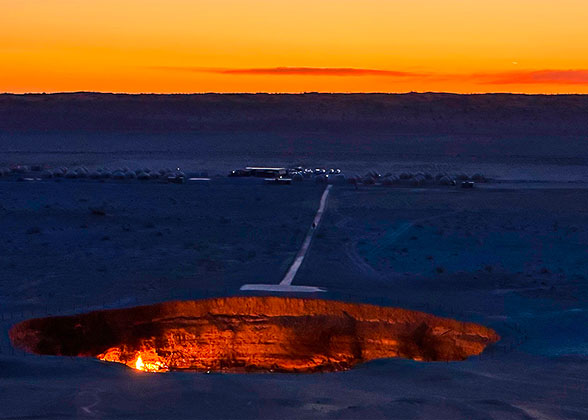
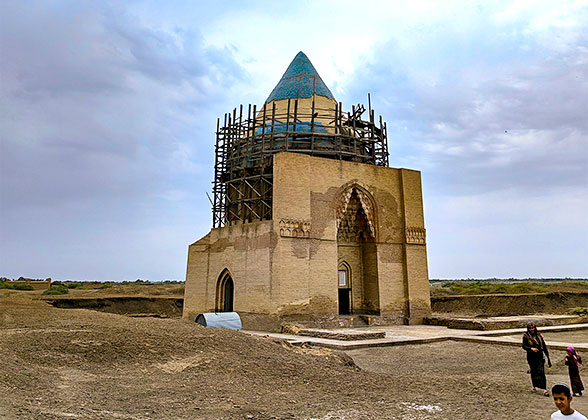
★ Darvaza Gas Crater: An Open Fiery Mouth of the Earth
Afterward, continue our journey to the Darvaza Gas Crater, and visit the Mud and Water Craters en route. Upon arrival, you’ll witness thousands of flames merging into a brilliant oval fire pit that spans 70 meters (230 feet) in diameter, which is sure to ignite your imagination. From a nearby hill, the crater resembles a glowing and wide-open mouth, an eerie image that has earned it the title “Door to Hell”. As night falls, the flames look more vibrant, creating a spectacle against the dark desert sky. Remember to maintain a safe distance from unstable rocky edges, and drink enough water to stay hydrated amidst the intense heat and smoke.In the evening, we’ll enjoy a BBQ dinner and spend the night at a nearby yurt camp, which provides pillows, sleeping bags, and mats. For the cool night air, you can bring a cardigan and thick socks to keep warm.
Meals: Breakfast, Dinner
Accommodation: Yurt camp in Darvaza

Darvaza Gas Crater

Kunya Urgench Historical Park
Day 3 Drive 5 Hours to Kunya Urgench; Transfer to Khiva, Uzbekistan
This morning, consider waking up early to watch a stunning desert sunrise and see the ‘Door to Hell’ in daylight. Then, we’ll drive 5 hours to Kunya Urgench Historical Park for today’s exploration. Kunya Urgench, the once-glorious capital of the Khorezmian Empire (1077-1231), also known as Gurganj, thrived thanks to the influx of merchants and scholars along the ancient Silk Road. However, its splendor was shattered due to the 13th-century Mongol invasion. The main remaining relics are mausoleums built with baked bricks and mosques decorated with glazed bricks, cutting bricks, and plaster, dating back to the city’s restoration in the Golden Horde era (1243-1502).
Follow our guide to explore remnants like Turabek Khanum Mausoleum, Kutlug Timur Minaret, and Il Arslan Mausoleum, marveling at the ingenuity of ancient craftsmen. Especially, the Kultug Minaret is regarded as one of the tallest minarets in Central Asia, standing at 60 meters (197 feet) high and visible from 30 km (19 miles) away. Also, the Il Arslan Mausoleum has a distinguished conical dome embellished with serrated patterns, paving the way for later architectural styles across Uzbekistan.
► How Did the Mongols Destroy Kunya Urgench?
Genghis Khan instructed his three sons to conquer Kunya Urgench, and they quickly entered after fierce attacks. However, intense local resistance and a dispute between his eldest son, who sought to preserve the city’s wealth, and his second son, who wanted to raze it to the ground, led to minimal progress during the seven-month siege. Thus, Genghis Khan changed his strategy, and Kunya Urgench was overrun following a ruthless massacre brought by his third son, marking one of the most tragic battles of the Mongolian west expedition. Nearly all residents were killed; only a few craftsmen were taken to the East, and young women and children were enslaved. Eventually, the Mongols destroyed the dam on the Amu Darya River, and the city was flooded and turned into ruins.
Following this, you’ll be escorted to the Uzbekistan border to deal with the frontier formalities, which may take some time. So, we suggest preparing water and snacks. After crossing the border, our Uzbekistan driver will pick you up and whisk you to the hotel in Khiva for check-in.
 Visa Tip: Citizens from 90 countries, including the UK, Mexico, New Zealand, Russia, and Switzerland, can enter Uzbekistan visa-free, which is also eligible for US citizens under the age of 16 or over 55. For others, an e-visa is required, and a single-entry visa costs USD 20.
Visa Tip: Citizens from 90 countries, including the UK, Mexico, New Zealand, Russia, and Switzerland, can enter Uzbekistan visa-free, which is also eligible for US citizens under the age of 16 or over 55. For others, an e-visa is required, and a single-entry visa costs USD 20.
Meals: Breakfast
Accommodation: Hotel Asia Khiva (3 stars) or similar
Follow our guide to explore remnants like Turabek Khanum Mausoleum, Kutlug Timur Minaret, and Il Arslan Mausoleum, marveling at the ingenuity of ancient craftsmen. Especially, the Kultug Minaret is regarded as one of the tallest minarets in Central Asia, standing at 60 meters (197 feet) high and visible from 30 km (19 miles) away. Also, the Il Arslan Mausoleum has a distinguished conical dome embellished with serrated patterns, paving the way for later architectural styles across Uzbekistan.
► How Did the Mongols Destroy Kunya Urgench?
Genghis Khan instructed his three sons to conquer Kunya Urgench, and they quickly entered after fierce attacks. However, intense local resistance and a dispute between his eldest son, who sought to preserve the city’s wealth, and his second son, who wanted to raze it to the ground, led to minimal progress during the seven-month siege. Thus, Genghis Khan changed his strategy, and Kunya Urgench was overrun following a ruthless massacre brought by his third son, marking one of the most tragic battles of the Mongolian west expedition. Nearly all residents were killed; only a few craftsmen were taken to the East, and young women and children were enslaved. Eventually, the Mongols destroyed the dam on the Amu Darya River, and the city was flooded and turned into ruins.
Following this, you’ll be escorted to the Uzbekistan border to deal with the frontier formalities, which may take some time. So, we suggest preparing water and snacks. After crossing the border, our Uzbekistan driver will pick you up and whisk you to the hotel in Khiva for check-in.
Meals: Breakfast
Accommodation: Hotel Asia Khiva (3 stars) or similar
Day 4 Khiva: Kalta Minor Minaret, Juma Mosque, Tosh-Hovli Palace, Islam Khodja Minaret
Today is dedicated to uncovering Khiva, Uzbekistan’s first city listed as a UNESCO World Cultural Heritage site, which has a history of over 1,500 years. Walk with your guide to unveil its well-preserved inner city, Ichan Kala, filled with mosques, minarets, and mausoleums in Islamic design. Our first stop will be the Muhammad Aminkhan Madrasah, which features five domes and a glazed brick façade. Followed by Muhammad Rahim Khan Madrasah, it houses 76 rooms and each has a carved wooden door and a white geometric grid window.
Next, proceed to the Kalta Minor Minaret, the first structure you see upon entering the city, which is 29 meters (95 feet) high and adorned with shimmering turquoise and white tiles. If it had been built to the intended height of 110 meters (360 feet), it would have dominated Central Asia’s skyline, but the construction was halted after the death of the Khan who commissioned it. Moreover, there is an exchange point nearby where you can exchange a small amount of Som (USD 1≈UZS 13,000) if you need.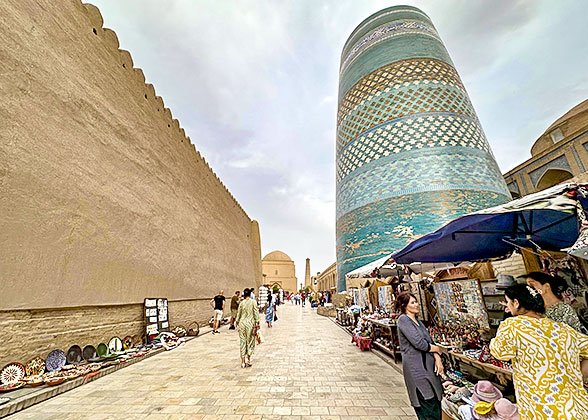
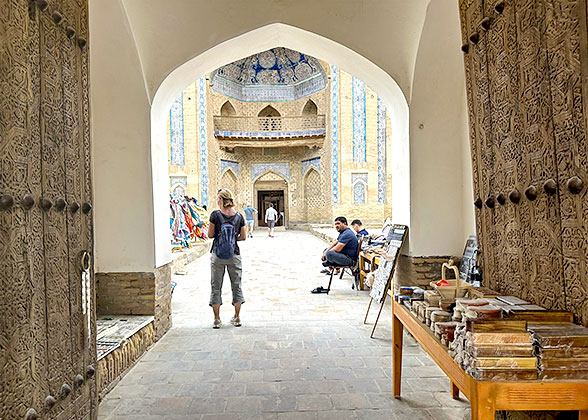 From here, we’ll then head to Juma Mosque, unique among the inner city’s mosques for lacking a dome and a courtyard. Its highlights are the 218 carved wooden columns, inviting you to run your fingers along their exquisite floral patterns. Wander ahead to the Tosh-Hovli Palace, which was the opulent residence of Allakuli Khan and his concubines, characterized by white and blue majolica slabs, geometric and floral mosaics, and copper grilles on the windows. Surprisingly, no decorations are repeated here, and no wonder it took about 8 years to build. After admiring the captivating green enamel dome of the Pahlavan Mahmud Mausoleum, you’ll ascend to the Islam Khodja Minaret and Kunya-Ark for panoramic views of Khiva, overlooking more than 60 ancient ruins within the city. It’s all for today’s discovery, and then you’ll be escorted back to the hotel.
From here, we’ll then head to Juma Mosque, unique among the inner city’s mosques for lacking a dome and a courtyard. Its highlights are the 218 carved wooden columns, inviting you to run your fingers along their exquisite floral patterns. Wander ahead to the Tosh-Hovli Palace, which was the opulent residence of Allakuli Khan and his concubines, characterized by white and blue majolica slabs, geometric and floral mosaics, and copper grilles on the windows. Surprisingly, no decorations are repeated here, and no wonder it took about 8 years to build. After admiring the captivating green enamel dome of the Pahlavan Mahmud Mausoleum, you’ll ascend to the Islam Khodja Minaret and Kunya-Ark for panoramic views of Khiva, overlooking more than 60 ancient ruins within the city. It’s all for today’s discovery, and then you’ll be escorted back to the hotel.
► Free Time Suggestion:
The soul of Khiva lies in its local life hiding in winding alleys. After revitalizing, you can unveil it by observing vendors weave exquisite silk items or visiting traditional wood carving workshops that produce the wooden pillars gracing Uzbekistan’s architecture. At sunset, consider treating yourself at the Terrassa Café & Restaurant, where you can take in perfect vistas of minaret and mosque silhouettes while enjoying a refreshing drink on its terrace. If you’re interested, remember to make a reservation in advance.
Meals: Breakfast
Accommodation: Hotel Asia Khiva (3 stars) or similar
Next, proceed to the Kalta Minor Minaret, the first structure you see upon entering the city, which is 29 meters (95 feet) high and adorned with shimmering turquoise and white tiles. If it had been built to the intended height of 110 meters (360 feet), it would have dominated Central Asia’s skyline, but the construction was halted after the death of the Khan who commissioned it. Moreover, there is an exchange point nearby where you can exchange a small amount of Som (USD 1≈UZS 13,000) if you need.

Kalta Minor Minaret, Khiva

Visit the Ichan Kala of Khiva
► Free Time Suggestion:
The soul of Khiva lies in its local life hiding in winding alleys. After revitalizing, you can unveil it by observing vendors weave exquisite silk items or visiting traditional wood carving workshops that produce the wooden pillars gracing Uzbekistan’s architecture. At sunset, consider treating yourself at the Terrassa Café & Restaurant, where you can take in perfect vistas of minaret and mosque silhouettes while enjoying a refreshing drink on its terrace. If you’re interested, remember to make a reservation in advance.
Meals: Breakfast
Accommodation: Hotel Asia Khiva (3 stars) or similar
Day 5 Drive 7 Hours to Bukhara, Pass by Kyzylkum Desert and Amu Darya River
In the morning, the driver will lead you to Bukhara in 7-8 hours. Along the way, you’ll cross the vast Kyzylkum Desert and pause to admire the scenery of the Amu Darya River, Uzbekistan’s longest river, known for its stark beauty as if coming from another planet. With limited dining options available along the way, we advise packing some snacks and enough water before leaving Khiva. After arriving at Bukhara, check into a local hotel and have a good rest.
Dating back over 2,500 years, Bukhara flourished as the capital of the Samanid Dynasty from the 9th to 10th centuries before it was ravaged by Genghis Khan in the 13th century and subsequently occupied by Timur in the 14th century. Until the foundation of the Khanate of Bukhara (1500-1920), it thrived again and was brimming with more than 170 Islamic architectural wonders since the Middle Ages. Tomorrow, our guide will lead you to explore some of them.
► Dinner Suggestion (at your own expense):
Tonight, try savoring local cuisine at the Joy Chaikhana Lounge Restaurant, which operates until 23:00 and has been renovated from an ancient caravansary, blending traditional tilework with modern elements like a disco ball. Lagman is a popular dish with layered flavors, featuring wide noodles stewed with lamb, carrots, and onions. Another must-try is the Stewed Beef, marinated in red wine and simmered with tomato sauce and potatoes, ideal for pairing with rice. Be sure to make a reservation in advance because of its popularity!
Average Cost per Person: UZS 100,000-150,000 (USD 8-12)
Address: 2, Sarafon Street, Bukhara 200100 Uzbekistan
Meals: Breakfast
Accommodation: Volida Hotel Bukhara (3 stars) or similar
Dating back over 2,500 years, Bukhara flourished as the capital of the Samanid Dynasty from the 9th to 10th centuries before it was ravaged by Genghis Khan in the 13th century and subsequently occupied by Timur in the 14th century. Until the foundation of the Khanate of Bukhara (1500-1920), it thrived again and was brimming with more than 170 Islamic architectural wonders since the Middle Ages. Tomorrow, our guide will lead you to explore some of them.
► Dinner Suggestion (at your own expense):
Tonight, try savoring local cuisine at the Joy Chaikhana Lounge Restaurant, which operates until 23:00 and has been renovated from an ancient caravansary, blending traditional tilework with modern elements like a disco ball. Lagman is a popular dish with layered flavors, featuring wide noodles stewed with lamb, carrots, and onions. Another must-try is the Stewed Beef, marinated in red wine and simmered with tomato sauce and potatoes, ideal for pairing with rice. Be sure to make a reservation in advance because of its popularity!
Average Cost per Person: UZS 100,000-150,000 (USD 8-12)
Address: 2, Sarafon Street, Bukhara 200100 Uzbekistan
Meals: Breakfast
Accommodation: Volida Hotel Bukhara (3 stars) or similar
Day 6 Bukhara: Lyabi Hauz Ensemble, Chor-Minor Madrasah, Kalyan Minaret, Samanid Mausoleum
Today, the guide will show you around Bukhara on foot, beginning with the Lyabi Hauz Ensemble. This architectural complex is the heart of the old town, where mulberry trees shade many pools and Islamic schools. You can absorb the tranquil ambiance or appreciate the Khoja Nasreddin Statue, riding a donkey as he traveled through Central Asia and the Middle East, famous for his humor and wisdom in getting out of trouble. After visiting the Magoki-Attori Mosque, stroll through high-walled alleys to see the four bright turquoise minarets of Chor-Minor Madrasah. These minarets are believed to represent the world’s four main religions, with some elements looking like crosses, Christian fish, and Buddhist prayer wheels. Try to capture it at the right angle and get a photo like the cover of Lonely Planet!
Our next stop is the Trade Domes Market, once a Silk Road market, which now mainly sells souvenirs. Then we’ll pay a visit to the face-to-face Ulugh Beg Madrassah and Abdulaziz Khan Madrassah, which is more ornate than the former with its stunning gate decorations. Afterward, we’ll appreciate the Po-i-Kalyan Complex, including the Kalyan Minaret, the Kalyan Mosque, and the Miri-Arab Madrasah. Legend has it that when the Mongol army invaded Bukhara, they demolished everything except for the Kalyan Minaret. Genghis Khan’s hat fell off when he looked up at this once-tallest structure in Bukhara at a height of 47 meters (154 feet), and after picking it up, he realized it was the only place in Central Asia that made him bow down, leading him to order his troops to preserve it.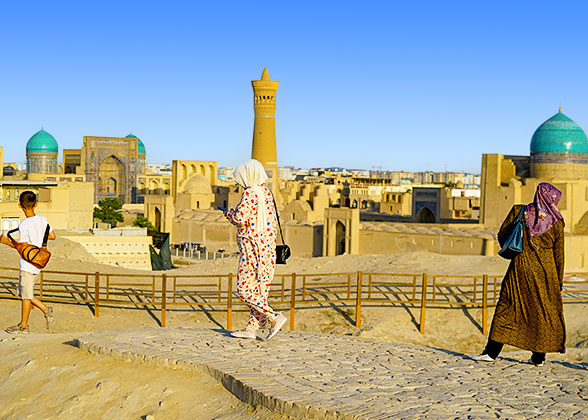
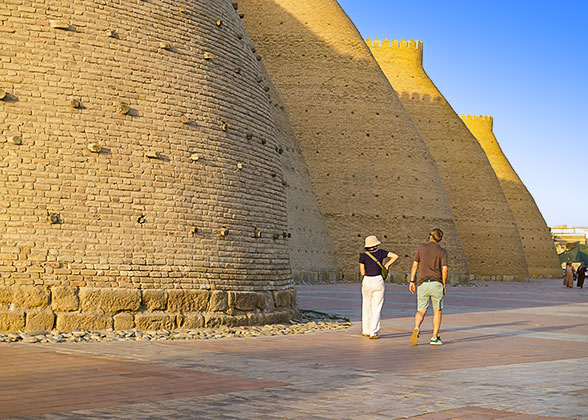 Next, we’ll move towards the Ark Fortress, which dates back to the 5th century BC. Its interior features rooms in various functions, including the ruler’s palaces, mosques, jewelry warehouses, a mint, and a prison. Some areas have now been transformed into a museum, where you can see the Emir’s throne, ancient coins, and weapons. Climbing to the top offers a panoramic view of ancient Bukhara. From here, we’ll walk to the opposite Bolo Hauz Mosque, known for its 20 delicately carved wooden pillars. Standing by the pond in front of the mosque, you’ll find the pillars reflected in the water, earning it the nickname “forty-pillar mosque”.
Next, we’ll move towards the Ark Fortress, which dates back to the 5th century BC. Its interior features rooms in various functions, including the ruler’s palaces, mosques, jewelry warehouses, a mint, and a prison. Some areas have now been transformed into a museum, where you can see the Emir’s throne, ancient coins, and weapons. Climbing to the top offers a panoramic view of ancient Bukhara. From here, we’ll walk to the opposite Bolo Hauz Mosque, known for its 20 delicately carved wooden pillars. Standing by the pond in front of the mosque, you’ll find the pillars reflected in the water, earning it the nickname “forty-pillar mosque”.
Afterward, let’s proceed to the Samanid Mausoleum, a splendid example of Persian artistry. Constructed using camel milk blended with liquid slurry, this building features baked bricks arranged in 22 patterns like circles, diamonds, and squares that transform under varying light conditions. Today’s sightseeing will conclude at the Chashma Ayub Mausoleum, after which you’ll be transferred to the hotel.
Meals: Breakfast
Accommodation: Volida Hotel Bukhara (3 stars) or similar
Our next stop is the Trade Domes Market, once a Silk Road market, which now mainly sells souvenirs. Then we’ll pay a visit to the face-to-face Ulugh Beg Madrassah and Abdulaziz Khan Madrassah, which is more ornate than the former with its stunning gate decorations. Afterward, we’ll appreciate the Po-i-Kalyan Complex, including the Kalyan Minaret, the Kalyan Mosque, and the Miri-Arab Madrasah. Legend has it that when the Mongol army invaded Bukhara, they demolished everything except for the Kalyan Minaret. Genghis Khan’s hat fell off when he looked up at this once-tallest structure in Bukhara at a height of 47 meters (154 feet), and after picking it up, he realized it was the only place in Central Asia that made him bow down, leading him to order his troops to preserve it.

Kalyan Minaret, Bukhara

Ark Fortress, Bukhara
Afterward, let’s proceed to the Samanid Mausoleum, a splendid example of Persian artistry. Constructed using camel milk blended with liquid slurry, this building features baked bricks arranged in 22 patterns like circles, diamonds, and squares that transform under varying light conditions. Today’s sightseeing will conclude at the Chashma Ayub Mausoleum, after which you’ll be transferred to the hotel.
Meals: Breakfast
Accommodation: Volida Hotel Bukhara (3 stars) or similar
Day 7 Bukhara: Summer Palace, Chor-Bakr Necropolis; Take a High-speed Train to Samarkand
Let’s continue our Bukhara exploration at the Summer Palace after breakfast. This structure is divided into two parts, with the old palace commissioned by Nasrullah Khan. Today, only its name remains, Sitora Mokhi Khosa, a tribute to the Khan’s love for his deceased wife, whom he hoped would be immortal like the moon. The new part was expanded by Said Alim Khan, Nasrullah Khan’s grandson, who was a fan of European and Russian architectural styles. You’ll notice the ceiling decorated with mosaics and stained glass, heart-shaped windows, and pink chairs from Berlin, all of which reflect his same romantic tendency as his grandfather.
After that, our guide will lead you to Chor-Bakr Necropolis, built to honor the four descendants of the prophet Muhammad, which has been attracting numerous ascetics and pilgrims since the 14th century despite its lack of splendid tiled decorations. It is said that visiting and praying at the four tombs in one day can make your wish come true. Why not try it? Next, we’ll go to the Memorial Complex of Bahouddin Naqshband, which is centered around Bahouddin Naqshband’s mausoleum. Bahouddin was a spiritual leader who believed in the wisdom of Sufis, but he devoted himself to silk weaving and metal engraving to sustain lives, rather than traditional wandering and dancing.
Then the driver will escort you to the train station for a 2-hour high-speed train to Samarkand. After arrival, a local driver will pick you up and whisk you to the hotel, and you can spend the rest of the day on your own.
► Dinner Suggestion (at your own expense):
After a short rest, perhaps you want to indulge in local cuisine, and the Emirhand Restaurant is a good choice. Book a terrace table on Instagram in advance to savor classic Central Asian dishes such as Plov (rice with diced vegetables) and Ali Nazik (kebab with smashed potatoes) while admiring a sunset over a nearby mosque’s blue dome. Don’t forget to sip a glass of white wine to relax in this grape-growing nation. Subsequently, meander to the square across the street and be dazzled by an array of colorful lights.
Average Cost per Person: UZS 200,000-250,000 (USD 15-20)
Address: Makhmudzhanova 1/18, Samarkand, 140100, Uzbekistan
Meals: Breakfast
Accommodation: Grand Samarkand Superior (4 stars) or similar
After that, our guide will lead you to Chor-Bakr Necropolis, built to honor the four descendants of the prophet Muhammad, which has been attracting numerous ascetics and pilgrims since the 14th century despite its lack of splendid tiled decorations. It is said that visiting and praying at the four tombs in one day can make your wish come true. Why not try it? Next, we’ll go to the Memorial Complex of Bahouddin Naqshband, which is centered around Bahouddin Naqshband’s mausoleum. Bahouddin was a spiritual leader who believed in the wisdom of Sufis, but he devoted himself to silk weaving and metal engraving to sustain lives, rather than traditional wandering and dancing.
Then the driver will escort you to the train station for a 2-hour high-speed train to Samarkand. After arrival, a local driver will pick you up and whisk you to the hotel, and you can spend the rest of the day on your own.
► Dinner Suggestion (at your own expense):
After a short rest, perhaps you want to indulge in local cuisine, and the Emirhand Restaurant is a good choice. Book a terrace table on Instagram in advance to savor classic Central Asian dishes such as Plov (rice with diced vegetables) and Ali Nazik (kebab with smashed potatoes) while admiring a sunset over a nearby mosque’s blue dome. Don’t forget to sip a glass of white wine to relax in this grape-growing nation. Subsequently, meander to the square across the street and be dazzled by an array of colorful lights.
Average Cost per Person: UZS 200,000-250,000 (USD 15-20)
Address: Makhmudzhanova 1/18, Samarkand, 140100, Uzbekistan
Meals: Breakfast
Accommodation: Grand Samarkand Superior (4 stars) or similar
Day 8 Samarkand: Registan Square, Bibi Khanym Mosque; High-speed Train to Tashkent
After breakfast, let’s explore Samarkand, which originated in 650 BC and was often called the “pearl of Central Asian cities” by some ancient explorers. Nearly destroyed by the Mongol army in 1220, it later became the capital of the Timurid Empire (1370-1507), where talented and skilled artisans from across Asia were brought to construct the most splendid structures.
Feast your eyes on Registan Square first, home to three madrasahs that represent the architectural zenith in the late 14th century. Among them, the Shir Dor Madrasah stands out from its arch decorated with tiger and human face motifs, although Islam prohibits idol worship and creature depictions. Why was it designed so unconventionally? Get the answer from our knowledgeable guide! Then we’ll go to the nearby Siyob Bazaar to uncover local life. A highlight is the bread street, where you can see over 17 kinds of bread, with some even sold in baby prams! The Bibi Khanym Mosque across the way was built to commemorate Timur’s beloved wife and was once the tallest façade in the Islamic world, featuring an impressive 38-meter (125-foot) high gate and 41-meter (135-foot) high dome. Unfortunately, Timur prioritized speed over quality in its construction, leading to its early deterioration; what you see today is a restoration completed in the 1970s.
Afterward, follow our guide to the Ulugbek Observatory, the biggest observatory of Central Asia during the Middle Ages, and the Shah-i-Zinda Necropolis, which is the resting place of Timur’s relatives and some military nobles. Finally, we’ll head to the Gur-Emir Mausoleum, which enchants you with its golden honeycomb dome, matching perfectly with the esteemed status of this great conqueror. After the tour, the driver will transfer you to the railway station for a 2-hour high-speed train to Tashkent. When arriving, you’ll be transferred to the hotel by the local driver.
Meals: Breakfast
Accommodation: Wyndham Tashkent (4 stars) or similar
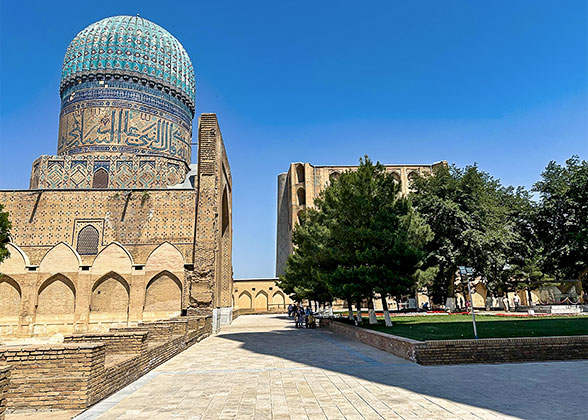
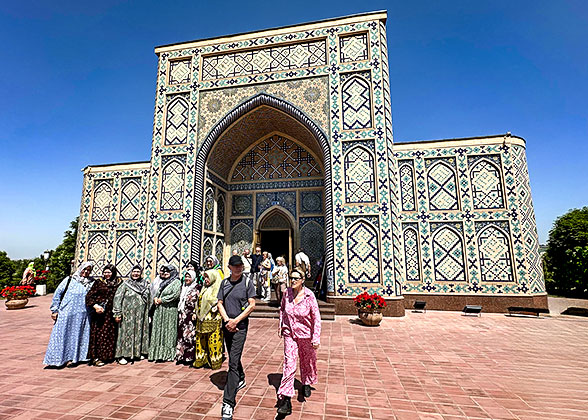
Feast your eyes on Registan Square first, home to three madrasahs that represent the architectural zenith in the late 14th century. Among them, the Shir Dor Madrasah stands out from its arch decorated with tiger and human face motifs, although Islam prohibits idol worship and creature depictions. Why was it designed so unconventionally? Get the answer from our knowledgeable guide! Then we’ll go to the nearby Siyob Bazaar to uncover local life. A highlight is the bread street, where you can see over 17 kinds of bread, with some even sold in baby prams! The Bibi Khanym Mosque across the way was built to commemorate Timur’s beloved wife and was once the tallest façade in the Islamic world, featuring an impressive 38-meter (125-foot) high gate and 41-meter (135-foot) high dome. Unfortunately, Timur prioritized speed over quality in its construction, leading to its early deterioration; what you see today is a restoration completed in the 1970s.
Afterward, follow our guide to the Ulugbek Observatory, the biggest observatory of Central Asia during the Middle Ages, and the Shah-i-Zinda Necropolis, which is the resting place of Timur’s relatives and some military nobles. Finally, we’ll head to the Gur-Emir Mausoleum, which enchants you with its golden honeycomb dome, matching perfectly with the esteemed status of this great conqueror. After the tour, the driver will transfer you to the railway station for a 2-hour high-speed train to Tashkent. When arriving, you’ll be transferred to the hotel by the local driver.
Meals: Breakfast
Accommodation: Wyndham Tashkent (4 stars) or similar

Bibi Khanym Mosque, Samarkand

Ulugbek Observatory, Samarkand
Day 9 Tashkent: Khast-Imam Complex, Chorsu Bazaar, Subway Stations, and State Museum of Applied Art
Today we’ll discover Tashkent. Although it may not rival the historically famed Silk Road cities like Samarkand and Khiva, it’s a sacred spiritual hub in the Islamic world. Start our sightseeing at the Khast-Imam Complex, which was built around the tomb of Hazrati Imam, having been revered by local Muslims for over a millennium. It comprises the well-preserved Barakhan Madrasah, Tillya Sheikh Mosque, Abu Bakr Kaffal Shashi Mausoleum, and Imam al-Bukhari Islamic Institute from the 10th to the 11th centuries, as well as the Hazrati Imam Cathedral Mosque built in 2007. To show respect, please remove your shoes before entering these buildings. Ladies should wear long robes and scarves.
Leaving the spiritual world, let’s plunge into the lively Chorsu Bazaar, marked by its giant blue dome. From common fruits and spices to freshly baked bread and delicious horse meat sausage, local life is all here. Interestingly, each stall sets a quail birdcage above, covered by a white cloth to create a safe environment for the birds so that they will chirp joyfully, bringing good luck to all, according to local beliefs. Then take the subway to the city center with our guide, and take in different themed stations along the way. In this underground gallery, some stations pay tribute to pioneers of space exploration, while some are painted with cotton patterns to display Uzbekistan’s agriculture.
Our driver will be waiting for you in the city center, and then we’ll drive to Independence Square (Mustakillik Square) and Amir Timur Square for a leisurely walk. Finally, let’s go to the State Museum of Applied Art, home to over 7,000 folk artworks about traditional crafts, from ceramics and ethnic fabrics to clothes and micro paintings. As the day comes to an end, we’ll transfer you back to the hotel.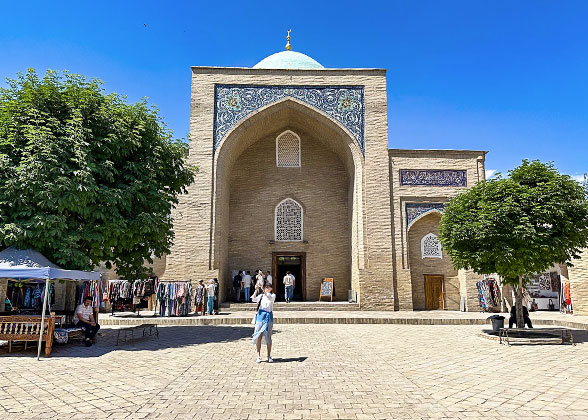
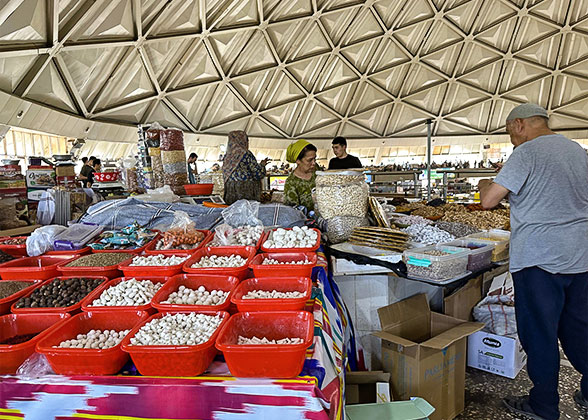 ► Activities Suggestion (at your own expense):
► Activities Suggestion (at your own expense):
For your last night in Uzbekistan, perhaps go to the Magic City Park downtown to experience Tashkent’s modern energy. Operating until 22:00, this theme park features a castle surrounded by play zones, live performance venues, shopping malls, and restaurants, reminiscent of Disney. Additionally, its streets are full of architecture in Paris, Barcelona, and London styles, making you feel like you’re in a fairy tale. Although the park is free to enter, please prepare some cash if you’d like to use the entertainment facilities.
Meals: Breakfast
Accommodation: Wyndham Tashkent (4 stars) or similar
Leaving the spiritual world, let’s plunge into the lively Chorsu Bazaar, marked by its giant blue dome. From common fruits and spices to freshly baked bread and delicious horse meat sausage, local life is all here. Interestingly, each stall sets a quail birdcage above, covered by a white cloth to create a safe environment for the birds so that they will chirp joyfully, bringing good luck to all, according to local beliefs. Then take the subway to the city center with our guide, and take in different themed stations along the way. In this underground gallery, some stations pay tribute to pioneers of space exploration, while some are painted with cotton patterns to display Uzbekistan’s agriculture.
Our driver will be waiting for you in the city center, and then we’ll drive to Independence Square (Mustakillik Square) and Amir Timur Square for a leisurely walk. Finally, let’s go to the State Museum of Applied Art, home to over 7,000 folk artworks about traditional crafts, from ceramics and ethnic fabrics to clothes and micro paintings. As the day comes to an end, we’ll transfer you back to the hotel.

Khast-Imam Complex, Tashkent

Chorsu Bazaar, Tashkent
For your last night in Uzbekistan, perhaps go to the Magic City Park downtown to experience Tashkent’s modern energy. Operating until 22:00, this theme park features a castle surrounded by play zones, live performance venues, shopping malls, and restaurants, reminiscent of Disney. Additionally, its streets are full of architecture in Paris, Barcelona, and London styles, making you feel like you’re in a fairy tale. Although the park is free to enter, please prepare some cash if you’d like to use the entertainment facilities.
Meals: Breakfast
Accommodation: Wyndham Tashkent (4 stars) or similar
Day 10 Departure from Tashkent of Uzbekistan, Airport See-off
It is the last day of your 10 days Uzbekistan Turkmenistan tour, and the driver will escort you to the airport according to your flight schedule and see you off. Bon Voyage!
► For Your Information: If your flight leaves in the late afternoon, you can visit the Amir Temur Square on your own, where a giant bronze statue of Timur on horseback stands proudly, with an inscription of “Rights is Justice” in four languages on its base. There is an interesting flea market on weekend. The historical buffs can explore the nearby Timur Museum to dive into his significance for Uzbekistan. The entrance fee is UZS 40,000 (USD 3), but the museum is closed on Mondays.
If this journey sparks your ideas to explore more of Central Asia, feel free to contact our travel consultant to extend your trip to Kyrgyzstan, Tajikistan, and Kazakhstan!
Meals: Breakfast
► For Your Information: If your flight leaves in the late afternoon, you can visit the Amir Temur Square on your own, where a giant bronze statue of Timur on horseback stands proudly, with an inscription of “Rights is Justice” in four languages on its base. There is an interesting flea market on weekend. The historical buffs can explore the nearby Timur Museum to dive into his significance for Uzbekistan. The entrance fee is UZS 40,000 (USD 3), but the museum is closed on Mondays.
If this journey sparks your ideas to explore more of Central Asia, feel free to contact our travel consultant to extend your trip to Kyrgyzstan, Tajikistan, and Kazakhstan!
Meals: Breakfast
Expand All
Collapse All
This trip can be customized to meet your individual needs!
Itineraries you may also like:
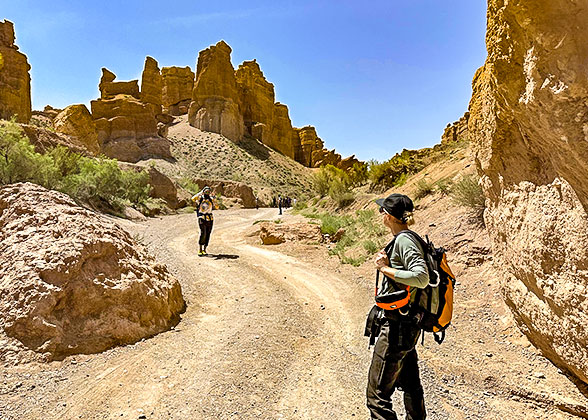 17 Days Tashkent - Khiva - Bukhara - Samarkand - Tashkent - Kokand - Fergana - Osh - Bishkek - Cholpon Ata - Karakol - Saty - Charyn Canyon - Almaty
17 Days Tashkent - Khiva - Bukhara - Samarkand - Tashkent - Kokand - Fergana - Osh - Bishkek - Cholpon Ata - Karakol - Saty - Charyn Canyon - Almaty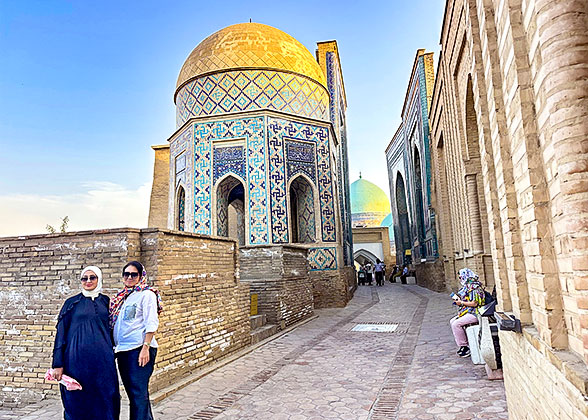 17 Days Tashkent - Khiva - Kunya Urgench - Darvaza - Ashgabat - Mary - Bukhara - Samarkand - Tashkent - Osh - Chon Kemin - Cholpon Ata - Bishkek
17 Days Tashkent - Khiva - Kunya Urgench - Darvaza - Ashgabat - Mary - Bukhara - Samarkand - Tashkent - Osh - Chon Kemin - Cholpon Ata - Bishkek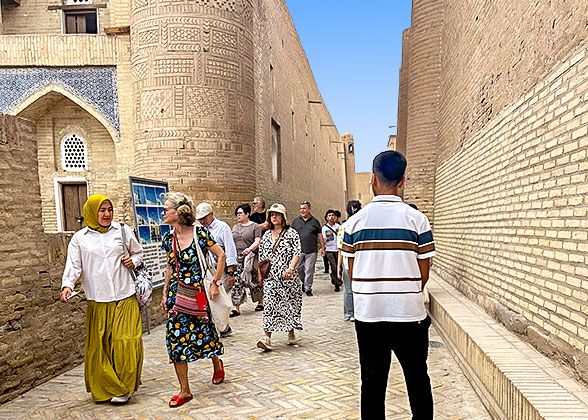 14 Days Tashkent - Khiva - Bukhara - Samarkand - Tashkent - Fergana - Osh - Bishkek - Cholpon Ata - Karakol - Jeti-Oguz - Skazka Canyon - Bokonbayevo - Bishkek
14 Days Tashkent - Khiva - Bukhara - Samarkand - Tashkent - Fergana - Osh - Bishkek - Cholpon Ata - Karakol - Jeti-Oguz - Skazka Canyon - Bokonbayevo - Bishkek
